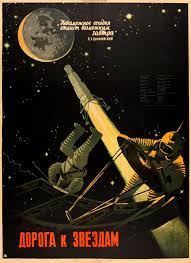
Konstantin Tsiolkovsky (Georgi Solovyov) was a Russian scientist. Almost deaf from an early age Konstantin was a teacher. Some considered him eccentric. In 1903 he published in “The Science Review Monthly” a paper called “The Exploration of Cosmic Space by Means of Reaction Devices”. Konstantin believed that one day man could and would travel into space. He spent years developing his theory of how man could escape gravity and safely travel to other planets.
Although some of his beliefs were still theoretical, he firmly believed it was possible. Having enough fuel to reach cosmic velocity was the problem. He determined that if a rocket was constructed in stages, one could release each stage as that portion of the rocket’s fuel was used up. This would allow for enough fuel and the release of excess weight would aid the rocket in escaping gravity.
The next step is to develop rocket technology. Fuels and rocket construction materials for both propulsion to space and in space once escape velocity is reached. Various scientists such as Professor Robert Goddard and Max Valier experimented with rocketry and furthered the advancements into space exploration.
From there man’s imagination travels into space and constructs a space station to aid in observing Earth's weather as well as improving man’s ability to live in space. Using the space station as a launching platform man travels to the moon and creates cities, observatories and mining facilities.
“Road to the Stars” was released in 1957 and was directed by Pavel Klushantsev. It is a Russian part documentary part science fiction film. The film was released right after the launch of the Soviet satellite “Sputnik 1”. Klushantsev also directed “Planeta bur” 1962, a wonderful Soviet science fiction film that Roger Corman ground up and spit out as “Voyage to the Prehistoric Planet” 1965 and “Voyage to the Planet of Prehistoric Women” 1968.
The first part of “Road to the Stars” relates the life of the man considered the founder of Soviet astronautics, Konstantin Tsiolkovsky as well as other facets of the development of rocket technology. The second part of the film imagines the future where humans not only go into space but colonize the moon. The first part may be a little on the slow side but once you get into the realm of the possible the movie becomes a great science fiction movie.
The cinematography and special effects are fantastic. Many have commented that some of the effects shots in Stanley Kubrick’s film “2001: A Space Odyssey” resemble Klushantsev’s shot for shot.
Some of the space ship footage was used as stock footage in the Mexican science fiction movie “The Ship of Monsters” 1960.

